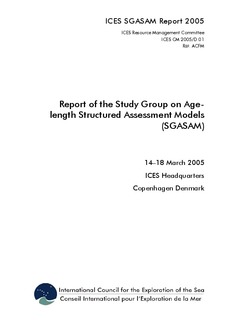| dc.contributor.author | ICES | |
| dc.date.accessioned | 2007-08-02T12:22:21Z | |
| dc.date.issued | 2005 | |
| dc.identifier.citation | This report is not to be quoted without prior consultation with the General Secretary. | |
| dc.identifier.uri | http://hdl.handle.net/11250/100747 | |
| dc.description | Contributor: Daniel Howell | |
| dc.description.abstract | The second meeting of the ICES Study Group on Age-length Structured Assessment Models
(SGASAM) was held at ICES Headquarters from 14-18 March 2005. There were 12 participants
(mainly with expertise in age-length structured modelling and stock assessment) from 10
countries. The main objective of SGASAM is to investigate and evaluate the use of lengthstructured
and age-length structured population models in fish stock assessment. The terms of
reference for this meeting related to both model development and species-specific applications.
Developments in methodologies and applications. An increasing number of age-length structured models are being developed (e.g. GADGET,
CALEN, Stock Synthesis) and applied to a wide variety of species with differing life-histories.
The acceptance of these for use in stock assessment is increasing, particularly outside of the
ICES area. There is growing interest in the development of simpler length-structured models
for the assessment of species for which age-structured data are unavailable and in particular, a
number of length-structured models have been developed which make use only of lengthstructured
survey data to obtain information on stock trends. These are clearly useful for
stocks for which commercial catch data may also be unreliable.
Incorporating process sub-models.
Process models previously developed by the ICES Study Group on Growth, Maturity and
Condition in Stock Projections were specifically considered. Many of these are lengthdependent
and some, particularly for growth and maturity, have already been included into
existing age-length structured modelling frameworks (e.g. GADGET). Further improvements
to the implementation of these process models in age-length structured population models
(important for the assessment of species where biological and fishery processes are better represented
by length) will require greater co-operation between process modellers and agelength
structured population modellers. It is therefore recommended that process modellers be
encouraged to attend any further meetings of this SG.
Investigating complexity.
The SG identified two different ways in which age-length structured model frameworks could
be used to investigate the performance of models with different levels of complexity. One
approach was to consider age-length structured models as operating models to generate data
sets and then evaluate other simpler models (e.g. VPA, biomass dynamic) in terms of their
performance against the underlying ‘true’ system and perhaps also in terms of relative performance
against alternative management regime. The second approach was the comparison
of different sub-models within the same framework and comparing their performance in terms
of ‘goodness of fit’ to the underlying data. There is a need for development of formal statistical
methods to carry out these comparisons.
Case studies.
The alternative to more complexity is the development of simpler length-based approaches for
species for which age-disaggregated data are sparse or unavailable. A number of species for
which there are age-reading uncertainties (and hence limited age-based data) were considered
by the SG and the development of length-structured models is already in progress for some of
these. The SG felt that continuing work on such simpler approaches is important and would
be particularly useful for the assessment of species such as Nephrops, redfish, anglerfish and
some elasmobranchs. | en |
| dc.format.extent | 1679492 bytes | |
| dc.format.mimetype | application/pdf | |
| dc.language.iso | eng | en |
| dc.publisher | ICES | en |
| dc.relation.ispartofseries | ICES CM documents | en |
| dc.relation.ispartofseries | 2005/D:01 | en |
| dc.subject | stock assessment | en |
| dc.subject | bestandsberegning | |
| dc.title | Report of the Study Group on Age-length Structured Assessment Models (SGASAM) | en |
| dc.type | Working paper | en |
| dc.subject.nsi | VDP::Agriculture and fishery disciplines: 900::Fisheries science: 920::Resource biology: 921 | |
| dc.source.pagenumber | 67 s. | en |
